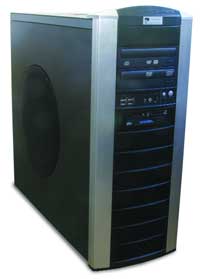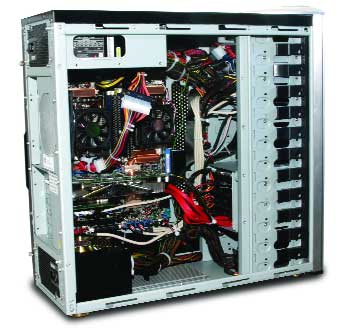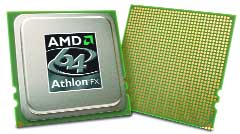A Powerful "4x4"
Polywell delivers a workstation based on the new AMD QuadFX CPU.
Polywell delivers a workstation based on the new AMD QuadFX CPU.
Latest News
FREE WEBINAR May 27: Addressing the Skilled Worker Shortage with Customized eLearning
America Makes’ Spring 2024 TRX Explores AM Advancements
ELEMENTS Version 4.2.0 Now Released
AMEXCI and Nikon SLM Solutions Collaborate in the Nordics
BMF Gets FDA OK for Ultra Thin Dental Veneer Material
Nexa3D and KVG Scale Defense Manufacturing Capabilities
All posts
December 4, 2001
By David Cohn
Polywell Computer has been specializing in custom-configured high-end workstations since 1987. The company sells servers, workstations, portables, rackmounts, and desktop PCs, all built using top-of-the line components. While we’ve known about Polywell for years, this is the first time we’ve had an opportunity to review one of the company’s computers. The San Francisco-based company sent us a Poly A680X2 SLi4 series workstation equipped with a pair of AMD Athlon 64 FX-74 CPUs, making this our first opportunity to look at AMD’s response to Intel’s quad-core CPUs.
 |  |
| The TX110 tower case and ASUS motherboard provide lots of expansion capabilities, with a total of 11 drive bays. Notice the two 700 watt power supplies and twin AMD QuadFX CPUs. | |
The FX-74 is the fastest of three new QuadFX “4x4” Athlon 64 CPUs recently introduced by AMD. Based on a 90 nanometer fabrication process, each processing core has its own 128KB Level 1 cache and 1MB Level 2 cache (for a total of 256KB L1 and 2MB L2 cache on each chip). Like the AMD Opteron, each FX CPU has its own dedicated dual-channel memory interface, with two DIMM slots associated with each processor, giving the new CPU a memory bandwidth of 25.6GBps, twice that of its predecessor. The new CPUs also don’t require expensive ECC memory, but instead use unbuffered DDR2 DIMMs. Each FX-74 has two HyperTransport (HT) links, one to its memory and the other to the other processor. Although you can configure a system with just one chip, AMD sells the processors in pairs, with two FX-74s priced at $999.
 The new AMD Athlon 64 FX-74 CPU beats at the heart of the new Polywell Poly A680X2 SLi4 workstation. |
Did You Say Expansion Capabilities?
The system came housed in a black and silver TX110 tower case from Cooler Master, measuring 8.62 in. 3 23 in. 3 21.75 in. and weighing in at a whopping 56 pounds, nearly equal in size and weight to the Dell Precision 690. A pair of thumbscrews secure the side panels. Removing the left panel, which has a large 11.5-in. diameter air port and filter, exposes the interior.
One of the most impressive aspects of the massive case is its 11 drive bays, all with front-panel access. Polywell made good use of these bays, filling six with a wide selection of drives (from top): a Sony 16x DVD +/-RW dual-layer drive, a Sony CDRW/DVD ROM combo drive, a 3.5-in. floppy drive that also had a built-in 7-in-1 media reader for CF/MD/SM/MS/SD/MMC cards, a Seagate 500GB SATA 7200rpm hard drive, and a pair of Western Digital 74GB SATA 10,000rpm hard drives with 16MB cache in a RAID array.
The front panel of the drive bay between the DVD drives and the floppy contained four USB ports, headphone and microphone jacks, a FireWire connector, and power and reset buttons. The system’s rear panel provided PS/2 mouse and keyboard ports, a 25-pin parallel port, four more USB ports, an external SATA port, an optical S/PDIF out port and a coaxial S/PDIF out port for connecting external audio output devices, and six audio ports: rear speaker out, center/subwoofer, line-in, line-out, microphone, and side speaker (for use in an 8-channel audio configuration). Curiously, the rear panel also contained a pair of RJ45 LAN ports, but these were covered by the Polywell serial number tag. Instead, Polywell installed a small LAN card in the system’s lone PCI expansion slot, which the company told us achieves better performance.
Inside the case we found an ASUS L1N64-SLI WS motherboard, an extended ATX form factor board based on the new NVIDIA nForce 680a chipset. The motherboard supports up to two AMD Athlon 64FX socket L1 CPUs, and our evaluation unit came with a pair of 3.0GHz FX-74 AMD processors. The motherboard provides six expansion slots: four PCI Express x16 slots (two x16 and two x8 electrically), a PCI Express x1 slot, and a PCI slot. The ASUS motherboard can support up to two identical NVIDIA graphics boards connected using NVIDIA’s SLI interface. Our evaluation unit came with a single NVIDIA Quadro FX 5500 graphics board with its own 1GB of onboard memory.
The graphics board covered the adjacent PCI Express x1 slot. There was also a thick bundle of audio cables routed to the internal audio connector on the motherboard. This could have caused some problems if we had needed to install an expansion card into one of the remaining PCI Express x16 slots.
The motherboard also provides support for two Ultra DMA 133/100 devices and up to 12 SATA devices, with RAID 0, 1, 0+1, 5, and JBOD (just a bunch of disks) configurations spanning across serial ATA devices via the onboard NVIDIA MediaShield RAID controller, so it’s definitely possible to fill all of those available drive bays. The motherboard also provides onboard Gigabit LAN support, as well as a SoundMAX High Definition Audio CODEC, support for two IEEE 1394 (FireWire) connectors, and up to 10 USB 2.0/1.1 ports.
The case also contained an abundance of fans. Each CPU had a 2.5-in. fan over its heat sink. There was a 4.0-in. fan on the rear panel, a 3.0-in. fan on the top of the case, and 4.0-in. diameter fans in each of the two 700 watt power supplies. In spite of all of these fans, the system proved to be extremely quiet.
The two power supplies proved to be one of the most curious aspects of this system. We were initially puzzled by the adhesive label on the rear of the system that read “pls make sure all power cords (x2) connect to this system before power on.” When we tried booting the system with just one power cord connected, the system refused to start. Connecting the second power cord quickly solved that problem. This is the first computer we’ve ever seen that requires two electrical connections, but with all those drive bays, you may need 1400 watts someday.
The ASUS motherboard provides four DIMM sockets, and accepts 240-pin DDR2 memory with data transfer rates of 400, 533, 667, and 800MHz. Our evaluation unit came with 4GB of memory installed using four 1GB 800MHz modules.
Benchmarking the QuadFX
Benchmarking multicore computers has become a real challenge. Few CAD applications are significantly multithreaded, nor are the benchmarks DE has traditionally used. These problems were further compounded by the architecture of the AMD QuadFX processor. The lack of NUMA support under Windows XP raises the potential that this powerful system could actually perform slower than expected.
For that reason, Polywell loaded both Windows XP Professional (32-bit) and Vista Ultimate (64-bit) in a dual-boot arrangement on our evaluation unit, and we attempted to perform our benchmarks under Vista as well. Unfortunately, our current benchmarks are all 32-bit applications and make extensive use of OpenGL.
The results were interesting, but inconclusive, with the Polywell system performing some tests faster under Vista while other tests refused to run at all under Vista. Overall, the AMD-based Polywell system appeared to be measurably faster than the HP xw9400, an AMD Opteron-based computer, but slower than systems based on the latest Intel CPUs. Complete XP test results are provided in the accompanying table (PDF).
Polywell rounded out the system with a beautiful 104-key Logitech Premium Desktop keyboard and wireless optical mouse. The company also provides a wealth of materials including the manual and CD for the ASUS motherboard, operating system recover disks, the actual operating system disks and license certificates, and disks for Nero 7 Essentials and PowerDVD. Polywell backs its systems with a five-year warranty that covers one-year limited parts replacement and five years labor. Extended third-party technical support and onsite parts replacement is available for an additional charge.
As our industry transitions from single core to multicore systems and from XP to Vista, it’s difficult to provide entirely definitive comparisons. But there is no doubt that parallel processing is the future. The Polywell Poly A680X2 SLi4 makes some of that future available today. A base system with one 74GB hard drive and a more modest NVIDIA Quadro FX 3500 costs $4,150. But even at $5,799 as tested, it’s not a bad premium for all of that power.
More Information
Polywell Poly A680x2 SLi4
> Price: $5,799 as tested
> Size: 8.62 in. 3 23.0 in. 3 21.75 in. (W3D3H) tower
> Weight: 56 pounds
> CPU: two AMD Athlon64 FX-74 processors
> Memory: 4GB
> Graphics: NVIDIA Quadro FX 5500
> Hard Disk: two Western Digital 74GB 10,000 rpm SATA; one Seagate 500GB 7,200 rpm SATA
> Floppy: 3.5 in. floppy with 7-in-1 card reader
> Optical: Sony dual layer 16X DVD+/-R/RW 48X CD-R/RW; Sony 2X32X52X CDRW + 16x DVD ROM combo drive
> Audio: integrated SoundMax High Definition Audio w/ 2 microphone, line-in, headphone, line-out, center/subwoofer out, side speaker out, optical S/PDIF out, and coaxial S/PDIF out
> Network: Gigabit LAN
> Modem: none
> Other: one 25-pin parallel, eight USB 2.0/1.1, two IEEE1394 FireWire, PS/2 keyboard, PS/2 mouse
> Keyboard: 104-key Logitech Premium Desktop keyboard
> Pointing device: two-button Logitech wireless optical wheel mouse (integrated with keyboard)
David Cohn is a computer consultant and technical writer based in Bellingham, WA and has been benchmarking PCs since 1984. He’s a contributing editor to Desktop Engineering, an applications engineer with The PPI Group, the former editor-in-chief of Engineering Automation Report and CADCAMNet, and the author of more than a dozen books. Please send comments about this article here. You can also contact David at [email protected] or at dscohn.com.
Subscribe to our FREE magazine, FREE email newsletters or both!
Join over 90,000 engineering professionals who get fresh engineering news as soon as it is published.
Latest News
FREE WEBINAR May 27: Addressing the Skilled Worker Shortage with Customized eLearning
America Makes’ Spring 2024 TRX Explores AM Advancements
ELEMENTS Version 4.2.0 Now Released
AMEXCI and Nikon SLM Solutions Collaborate in the Nordics
BMF Gets FDA OK for Ultra Thin Dental Veneer Material
Nexa3D and KVG Scale Defense Manufacturing Capabilities
All posts
About the Author
David Cohn is a consultant and technical writer based in Bellingham, WA, and has been benchmarking PCs since 1984. He is a Contributing Editor to Digital Engineering, the former senior content manager at 4D Technologies, and the author of more than a dozen books. Email at [email protected] or visit his website at www.dscohn.com.
Follow DE#9533
New & Noteworthy

New & Noteworthy: Safe, Cost-Effective Metal 3D Printing - Anywhere
Desktop Metal’s Studio System offers turnkey metal printing for prototypes and...

New & Noteworthy: Direct Neutronics Analysis on CAD
Coreform Cubit 2023.11 workflows enable neutronics directly on CAD for next-generation nuclear energy...

New & Noteworthy: Agile Engineering Collaboration
Authentise Threads is a new software tool for distributed communications and project...

New & Noteworthy Product Introduction: Enterprise VR Headset
Lenovo ThinkReality VRX has an immersive display works with virtual, augmented and...


